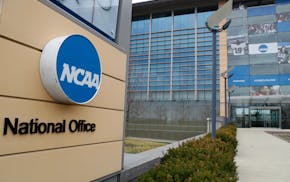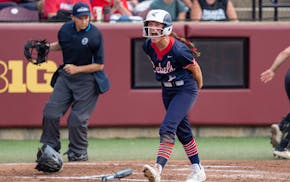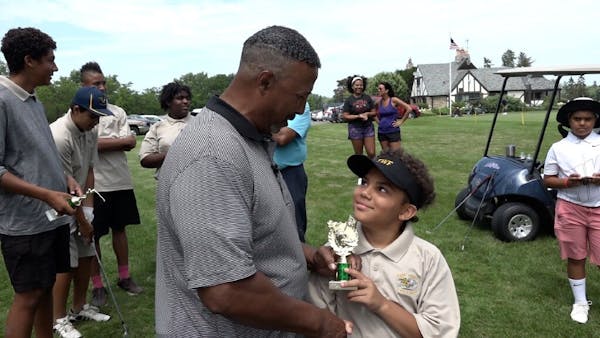A Park Board committee narrowly approved a plan to stabilize the Hiawatha Golf Course, which is plagued by flooding and hemorrhaging money, and create a nine-hole beginner course in place of an 18-hole golf course celebrated as one of the state's first to allow Black players.
How to protect Hiawatha Golf Course from the elements while adequately honoring history has been a protracted and emotionally charged debate. A community advisory committee met for a year and a half. The draft concept plan received more than 1,100 public comments. Most assumed polar opposite views, either insisting on keeping 18 holes at any cost, or removing golf altogether.
Commissioners voted 3-2 on Wednesday, with white members voting in favor and Black members against, to advance the plan to the full board.
Following a public hearing Wednesday night in which most commenters favored the nine-hole plan as a "compromise," Commissioner Londel French expressed his disappointment.
"There's a lot of places in this country … places that didn't seem important, and white folks just wiped them out, and then 20 to 30 years later they said, 'Hey, we shouldn't have done that, that was messed up,' " he said. "There are places like that all over the country that have been decimated and destroyed for the sake of progress. Whose progress are we talking about?"
Commissioner Meg Forney urged the planning committee to consider that the new nine-hole plan would direct floodwaters through the course in a way that more closely resembles a natural system. "Our park system was bestowed a mud hole in exchange for racially covenanted developments adjacent to these flooded soils that grew wild rice," she said. "What is paramount in passing this plan is for the city's public works to wake [up] and mitigate the impacts of Mother Nature."
That brought a response from French. "Is it against Mother Nature for Black and brown folks to be enslaved and brought over to this country and still be prepared to do stuff that everybody else is doing, like play golf?" he said. "It's really odd that now we want to talk about Mother Nature and the environment and doing the right thing, but for hundreds of years we haven't done the right thing for Black folks."
Commissioner LaTrisha Vetaw added that she wouldn't vote for the nine-hole course until the plan adopted more specific assurances about how Black history would be preserved on site, as more than "just a plaque."
"We should have opportunities for wealth building for Black folks in this space. We should have some type of youth mentorship program. We should have more Black golfers employed throughout our system entirely," she said.
The Hiawatha Golf Course was created when the 19th century park architect Theodore Wirth dredged Lake Hiawatha and dumped the excess soil atop nearby Rice Lake, a wetland complex. The result: a golf course that sits below the elevation of Lake Hiawatha and floods with every major storm.
As climate change intensifies, rain increasingly renders large swaths of the course unplayable. In 2020, Minneapolis Parks and Recreation (MPRB) pumped 330 million gallons of water from the course into Lake Hiawatha to dry the turf and prevent neighboring homes from flooding.
"Around 242 million gallons, that's about what our consultants said is needed to satisfy the domestic water needs of a small- to medium-sized Minnesota town," said Parks Planning Director Michael Schroeder. "We're pumping lots of water."
The constant flooding also drains park funds. From 2008-2019, Hiawatha Golf Course lost $2.7 million, more than any other MPRB golf course. Golf's dire financial outlook is due to a combination of increasingly bad weather and declining interest in the sport since 2010, said Parks Finance Director Julia Wiseman.
Nevertheless, golf made a powerful comeback last year as the pandemic restricted most other sports. Wiseman speculates park users played more rounds of golf in 2020 than any other time in MPRB history. "For the golf industry, this increase in golf rounds due to the pandemic is nothing that they have ever seen," she said. "The last time they've seen an uptick in golf play was when Tiger Woods came onto the scene and a lot of young people all of a sudden wanted to play golf. So what this means for golf going into the future? How many people who tried to golf this year because of the pandemic fell in love with it? Will they continue to play into the years that follow? We certainly hope so."
Park staff's draft Hiawatha Golf Course master plan would redesign the entire terrain to carve a path through the property for floodwaters to flow into Lake Hiawatha. This would theoretically end the need to actively pump any water to keep the golf course dry, but creating that pathway means there would no longer be room for 18 holes, Schroeder explained.
"If we piled soils on top of the soils to keep the 18-hole golf course, we would be filling the flood plain. And it means when there is a flood, we'll be pushing those floodwaters to other places in the watershed, which could be streets or homes or businesses."
Black golfers were banned from Minneapolis golf clubs until about 1952. Pioneering golfers Solomon Hughes and Jimmy Slemmons established their own clubs and tournaments, including the Upper Midwest Bronze Golf Tournament. The 80-year historically Black contest was played on Gross Golf Course in 1939, Theodore Wirth Golf Course from 1940 to 1967, and Hiawatha Golf Course in 1968.
One of the main goals of the master plan is to celebrate "the history of Black golfers at the course and provide introduction to golf for people of color," but the plan doesn't detail what that means.
"Conversations with Black golfers must continue as the golf course design is developed so that these histories are baked into the design and not unjustly added later," according to the plan.
Susan Du • 612-673-4028

Federal judge approves $2.8B settlement, paving way for US colleges to pay athletes millions

United South Central wins Class 1A softball title with overpowering pitching

St. Cloud Cathedral endures a tense start, defeats Hawley for Class 2A softball state title

Softball state tournament: Champlin Park (4A), Rocori (3A), St. Cloud Cathedral (2A), United South Central (1A) are champs

